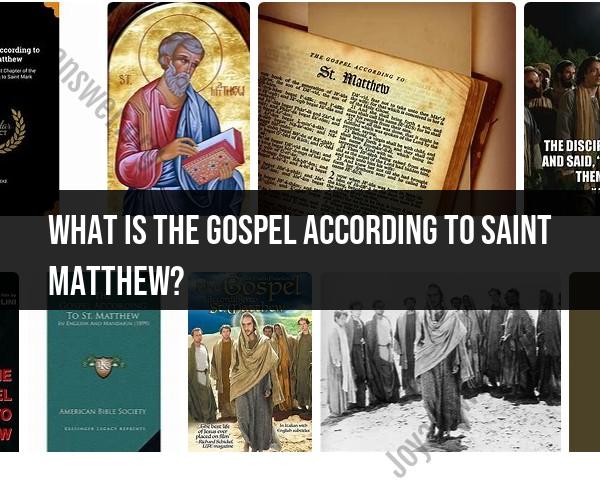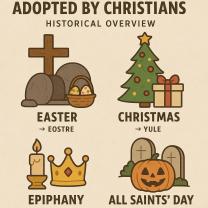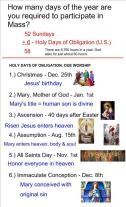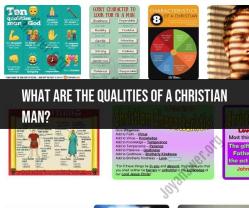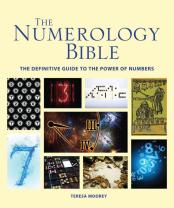What is the Gospel According to Saint Matthew?
The Gospel According to Saint Matthew, often referred to simply as the "Gospel of Matthew," is one of the four canonical Gospels in the New Testament of the Christian Bible. It is attributed to Saint Matthew, one of the twelve apostles of Jesus Christ, and is considered one of the Synoptic Gospels, along with the Gospels of Mark and Luke. The term "synoptic" means "seen together," and these three Gospels share many common stories, teachings, and events in the life of Jesus.
Here is an overview of the Gospel According to Saint Matthew and some of its key themes:
Authorship: Traditionally, the Gospel of Matthew is attributed to the apostle Matthew, also known as Levi. While the authorship is ascribed to him, scholars debate whether he was the actual author or if the Gospel was written by someone else using his teachings and experiences.
Audience: The Gospel of Matthew appears to have been written primarily for a Jewish-Christian audience. It emphasizes the fulfillment of Old Testament prophecies in Jesus Christ and presents Jesus as the Messiah and King of the Jews.
Genealogy and Birth Narrative: Matthew's Gospel begins with a genealogy tracing Jesus's lineage back to King David and Abraham, emphasizing his royal and Messianic lineage. It also includes the story of Jesus' birth, the visitation of the Magi, and the flight to Egypt.
Teachings of Jesus: Much of Matthew's Gospel consists of the teachings and sermons of Jesus. The most famous of these is the Sermon on the Mount (Chapters 5-7), which includes the Beatitudes, the Lord's Prayer, and many ethical and moral teachings.
Miracles and Parables: Like the other Gospels, Matthew recounts numerous miracles performed by Jesus, such as healing the sick and raising the dead. It also includes parables, such as the Parable of the Sower and the Parable of the Good Samaritan, which convey spiritual and moral lessons.
Discipleship and Mission: Matthew highlights the call of the disciples and their commission to go and spread the Gospel to all nations (the Great Commission). It underscores the importance of discipleship and following Jesus.
Passion, Death, and Resurrection: The latter part of Matthew's Gospel focuses on the events leading to Jesus' crucifixion, his death on the cross, and his resurrection from the dead. It includes the Last Supper, the betrayal by Judas Iscariot, and the trial before Pilate.
Eschatological Themes: Matthew's Gospel contains eschatological themes, including Jesus' teachings about the end times, the signs of his coming, and the final judgment.
Community Life and Ethical Teachings: Matthew's Gospel provides guidance for Christian community life and offers ethical teachings on topics such as forgiveness, humility, and love for one's neighbor.
The Gospel According to Saint Matthew is a foundational text for Christianity, presenting a comprehensive portrait of Jesus as the fulfillment of Old Testament prophecies and the embodiment of God's kingdom on earth. It is an essential part of the Christian canon and has had a profound influence on Christian theology and practice throughout history.
The Gospel According to Saint Matthew, also known as the Gospel of Matthew, is the first book of the New Testament. It is one of the four synoptic Gospels, which means that it tells the story of Jesus' life, ministry, death, and resurrection in a similar way to the other three Gospels: Mark, Luke, and John.
The Gospel of Matthew was written for a Jewish audience, and it emphasizes Jesus' fulfillment of Old Testament prophecies. Matthew begins his Gospel by tracing Jesus' lineage back to King David, and he frequently quotes from the Old Testament to show how Jesus' words and deeds fulfilled messianic prophecies.
The Gospel of Matthew can be divided into five main sections:
- The infancy narrative (chapters 1-2): This section tells the story of Jesus' birth, baptism, and temptation.
- The Sermon on the Mount (chapter 5-7): This section contains some of Jesus' most famous teachings, such as the Beatitudes, the Lord's Prayer, and the Golden Rule.
- The ministry of Jesus (chapters 8-25): This section tells the story of Jesus' travels throughout Galilee and Judea, healing the sick, casting out demons, and teaching the people.
- The passion and resurrection (chapters 26-28): This section tells the story of Jesus' arrest, trial, crucifixion, and resurrection.
The Gospel of Matthew ends with Jesus commissioning his disciples to go and make disciples of all nations. Matthew's Gospel is a powerful and moving account of Jesus' life and ministry, and it has been a source of inspiration and comfort to Christians for centuries.
Here are some of the key messages and themes of the Gospel of Matthew:
- Jesus is the Messiah: Matthew emphasizes that Jesus is the Messiah, the promised deliverer of the Jewish people. He quotes extensively from the Old Testament to show how Jesus fulfilled messianic prophecies.
- The kingdom of heaven: Jesus' ministry is focused on bringing about the kingdom of heaven, which is a new era of peace, justice, and righteousness. Matthew teaches that the kingdom of heaven is already present in Jesus and his ministry, but that it will be fully realized in the future.
- Discipleship: Matthew's Gospel calls Christians to be disciples of Jesus. This means following his teachings and example and working to bring about the kingdom of heaven.
The Gospel of Matthew is a rich and complex book that has much to offer readers today. It is a powerful account of Jesus' life and ministry, and it is a source of inspiration and guidance for Christians.
